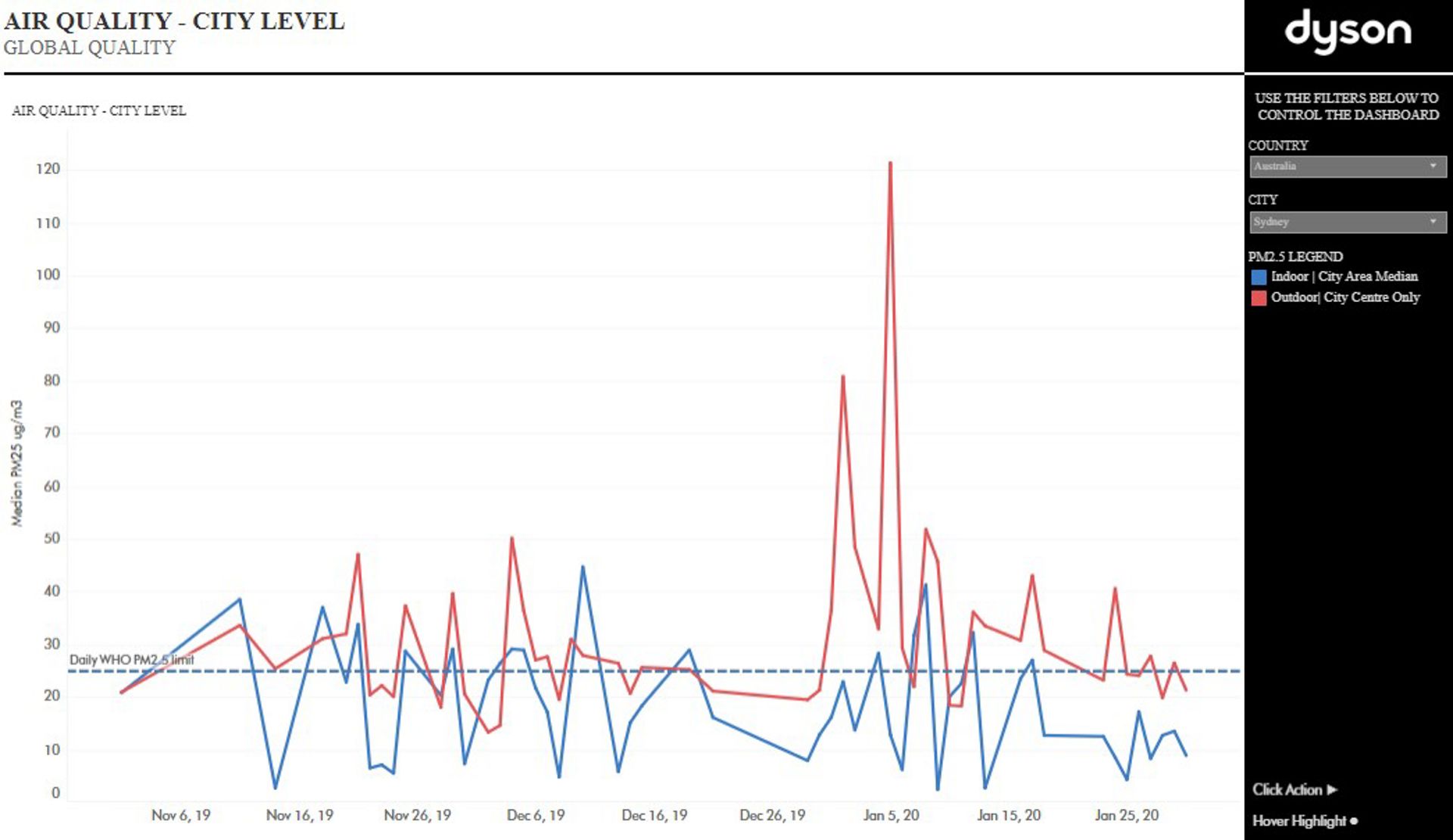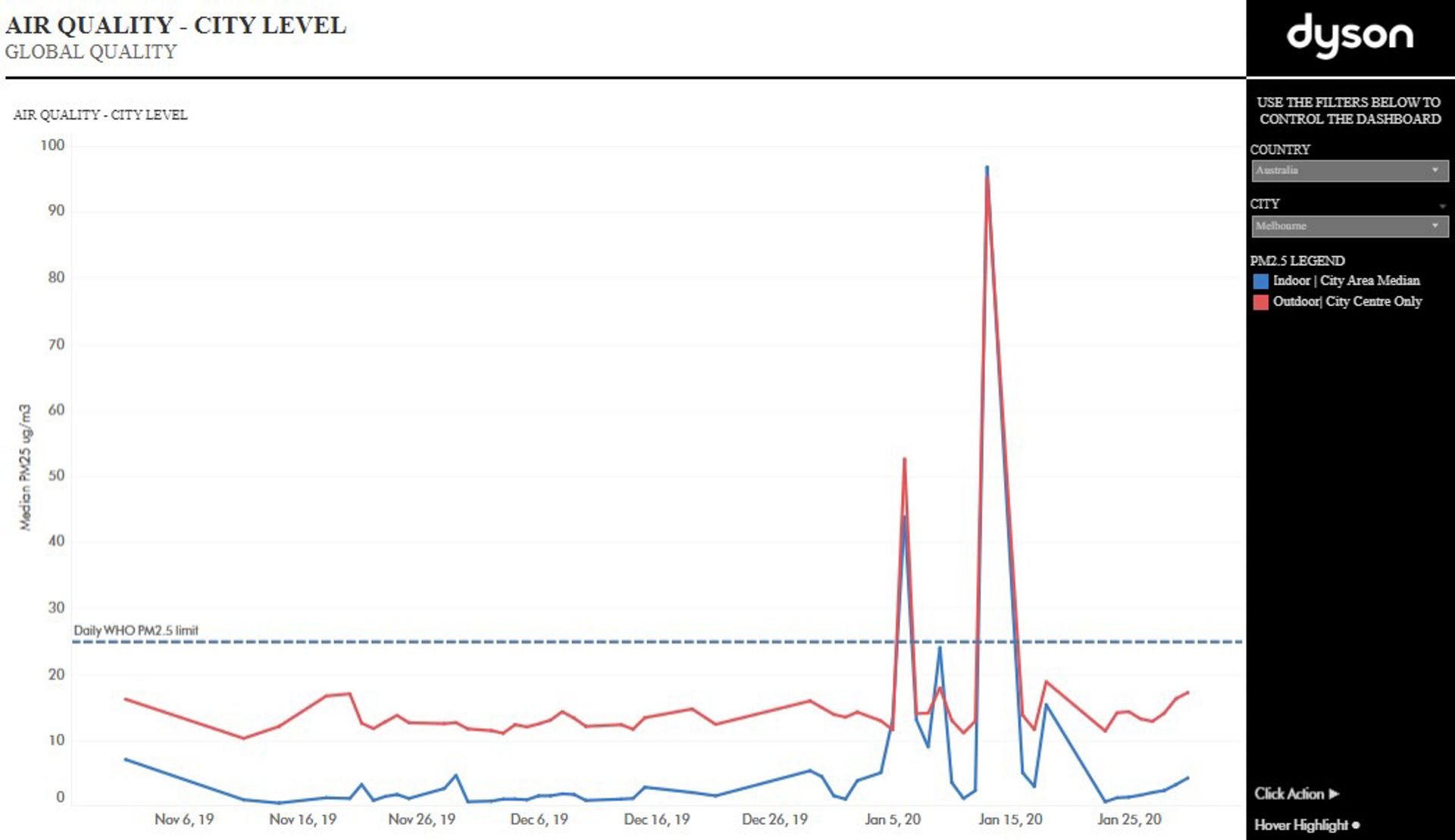-
Australia
Copyright © 2025 Powered by BCI Media Group Pty Ltd
Confirm Submission
Are you sure want to adding all Products to your Library?
Contact Detail

Bushfires are caused by natural phenomena and human activity, and bushfire season in Australia can have devastating effects. One of the major consequences of bushfire smoke is its impact on air - but how do bushfires affect air quality?
Bushfire smoke can travel long distances and linger for hours, days and sometimes weeks, and pose a risk to those near it. Leading air quality and health expert Professor Sotiris Vardoulakis and Dyson engineer David Hill provide advice on how to reduce your exposure to bushfire smoke. Ahead, see four measures that you can adopt to help protect yourself and your family against bushfire smoke health effects.
Sydney Air Quality

Melbourne Air Quality

What is bushfire smoke?
Bushfire smoke is made up of different sized particles, water vapour, gases and other particle pollutants:
Importantly, bushfire smoke health effects are contributed to via burning plants and building materials that are picked up along the way1. When particles in the air increase, they can become visible, leading to smoke haze and the orange skies that are synonymous with bushfire season.
But in other cases, air pollution can be much less visible. While you may not see the same smoke haze inside your home, it is likely that some of that air pollution is making its way inside. In fact, outdoor PM2.5 - such as those particles found in bushfire smoke - is known to have a higher infiltration rate into homes, compared to the course and ultrafine PM size ranges.2
How can you reduce your exposure to bushfire smoke?
Healthy measures don’t only apply when bushfire smoke is present. As Professor Vardoulakis says, “People should consider adjusting their daily behaviours to mitigate the risks associated with air pollution, even outside of the bushfire season. Try avoiding busy highways, commute to work differently, increase ventilation when cooking, use more environmentally friendly cleaning products or use a purifier with a HEPA filter inside the home.” Dyson Design Engineer David Hill shares how to adopt four key measures to reduce your exposure to bushfire smoke and haze. See his tips as well as air purifiers for bushfire smoke below.
1. Stay indoors as much as possible
Unless you are asked to evacuate your area, staying inside can reduce your exposure to bushfire smoke, ashes and other air pollution. Bushfire smoke health effects apply to animals as well as humans, so it’s a recommended to keep pets indoors as well8.
It’s important to remember though that indoor air can still be impacted by outdoor pollution – including bushfire smoke and haze. In fact, studies have shown that some air pollution can infiltrate indoors even through closed windows9 To protect your indoor space, a HEPA standard air purifier can help to maintain clean air.
2. Use an air purifier indoors
As Professor Vardoulakis explains, “Air purifiers with HEPA filters, when appropriately used, can reduce exposure to smoke particles and significantly improve indoor air quality. Air purifiers with sealed HEPA filters combined with activated carbon filters can provide added protection from smoke as well as keep the air clean of everyday pollutants found in our homes.”
The best air purifier for bushfire smoke needs the highest standard of filtration technology. This is partly due to bushfires having the ability to release high amounts of carbon dioxide (CO₂) into the air, combined with other particles which should be avoided. Dyson’s air purifying technology improves indoor air quality by using HEPA filtration alongside the highest standard of materials and pioneering features such as air quality monitoring, to protect the inhabitants of your home and workplace:
Explore the range of Dyson Air Purifiers
3. Limit indoor pollution
Other factors alongside bushfire smoke and smoke haze can affect the health quality of your indoor air. Air pollution can be contributed to by a range of outdoor and indoor sources - such as cleaning sprays , exhaust fumes and building materials. To help improve the health of spaces like homes and workplaces, Dyson's engineers have committed to understanding the science of air and what impacts it. It can be helpful to avoid smoking and using gas stoves, wood-burning fireplaces, gas logs, and candles where possible, as those contribute to indoor air pollution.
4. Wear a facemask when outdoors
It's not advisable to go outside when bushfire smoke is present, but if you must, be sure to protect yourself by wearing an effective mask. According to Professor Vardoulakis, planning our daily activities to reduce exposure to outdoor pollution, and creating a clean air space in our own homes by keeping doors and windows shut and using an air purifier with a HEPA filter is probably the best option for most families.
Professor Sotiris Vardoulakis has been working with Dyson on its air quality backpack study in Sydney. Reworking existing technology used in its air purifiers, two Dyson prototype air quality backpacks were given to two Australian families to detect the air quality around them during their daily lives. The results from one of the participants, a Sydney-based mother, found spikes in air pollution including PM2.5, NO2 and VOCs during routine activities such as cooking, cleaning and travelling by car.
While outdoors, this form of air quality protection can also be experienced through the Dyson ZoneTM. Although face masks are effective, the air purifier visor provides a stream of purified air to both the nose and mouth through a sealed filtration system to remove city fumes4.
1 https://www.epa.gov/wildfire-smoke-course/why-wildfire-smoke-health-concern
2 Liu et al (2003). Particle Penetration through Building Cracks. Aerosol Sci Technol 37:565-573; Liu et al (2001) Modeling pollutant penetration across building envelopes. Atmos Environ 35:4451-4462; Long et al (2001) Using Time- and Size-Resolved Particulate Data to Quantify Indoor Penetration and Deposition Behaviour. Environ Sci Technol 2001 35:2089-2099 When air quality index levels sit between 100-149, the air can pose a risk to sensitive groups. When levels hit 100-149, the air is unhealthy to all, and levels of 200+ are considered hazardous3. During the Australian 2019/2020 bushfires, the mean population Air Quality Index (AQI) recorded “poor” to “hazardous” air quality levels across eastern-Australia4.
3 https://www.environment.nsw.gov.au/topics/air/understanding-air-quality-data/air-quality-categories/history-of-air-quality-reporting/about-the-air-quality-index
4 Graham AM, Pringle KJ, Pope RJ, Arnold SR, Conibear LA, Burns H, Rigby R, Borchers-Arriagada N, Butt EW, Kiely L, Reddington C, Spracklen DV, Woodhouse MT, Knote C, McQuaid JB. Impact of the 2019/2020 Australian Megafires on Air Quality and Health. Geohealth. 2021 Oct 1;5(10):e2021GH000454. doi: 10.1029/2021GH000454. PMID: 34723045; PMCID: PMC8536818. 5 Filter tested in an external lab (NO2, SO2, Ozone) in a laboratory setting (3m3 chamber at 23oC and 50% RH) at max air flow setting. Capture rates may differ depending on real life usage
6 http://www.bccdc.ca/health-info/prevention-public-health/wildfire-smoke
7 https://www.lung.org/clean-air/outdoors/who-is-at-risk/children-and-air-pollution
8 https://www.epa.gov/wildfire-smoke-course/which-populations-experience-greater-risks-adverse-health-effects-resulting
9 https://www.fs.usda.gov/Internet/FSE_DOCUMENTS/stelprdb5318238.pdf
10 Wang et al (2016) Indoor-outdoor relationships of PM2.5 in four residential dwellings in winter in the Yangtze River Delta, China. Environ Pollut 215:280-289
11 Particle challenge by DEHS oil specified in EN1822 within a chamber specified in ASTM F3150. Tested in Max Mode at IBR US, for whole machine efficiency above 99.95%





Save Company
Add All Products to My Library
Send Meeting Request to this Supplier